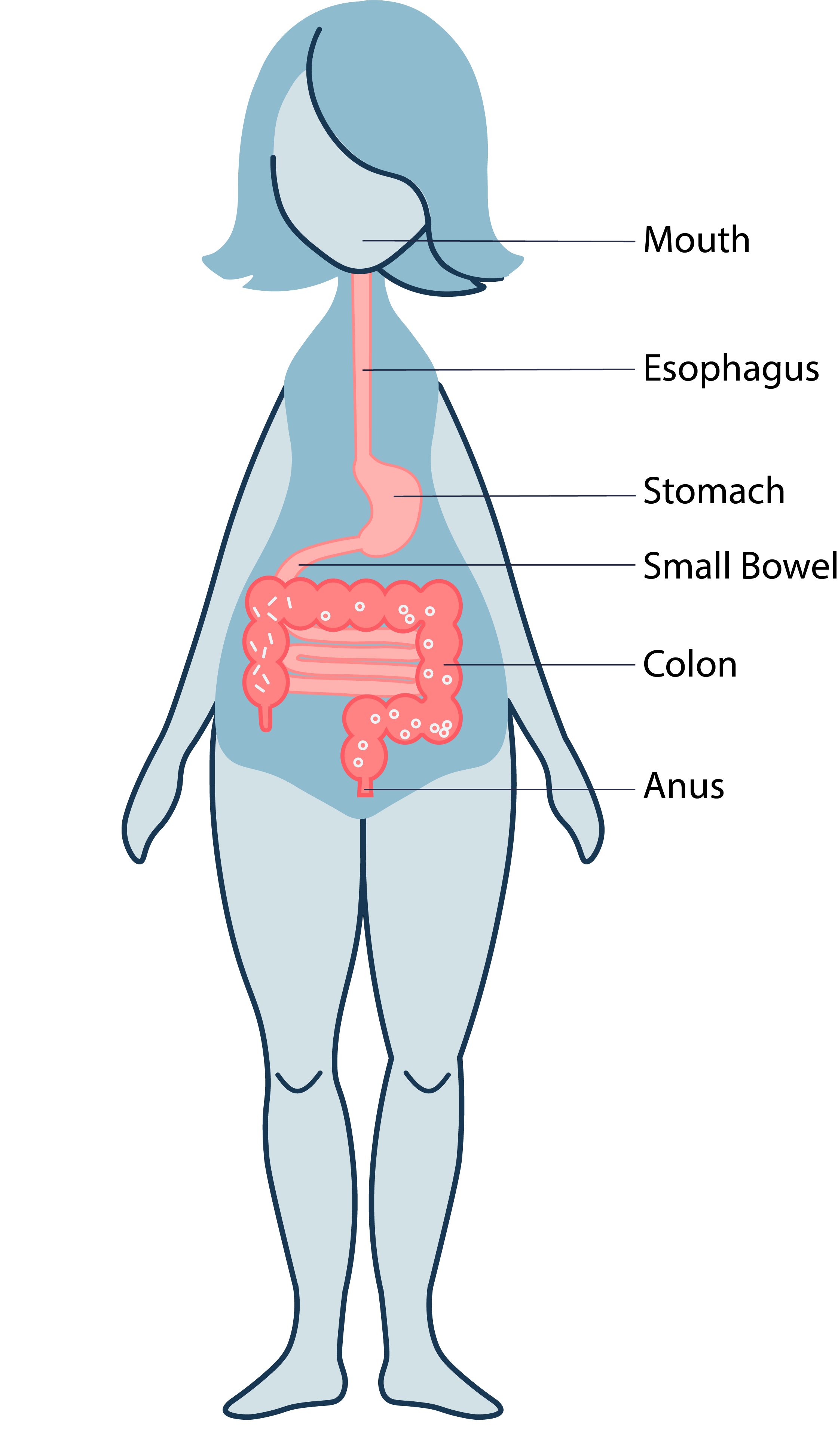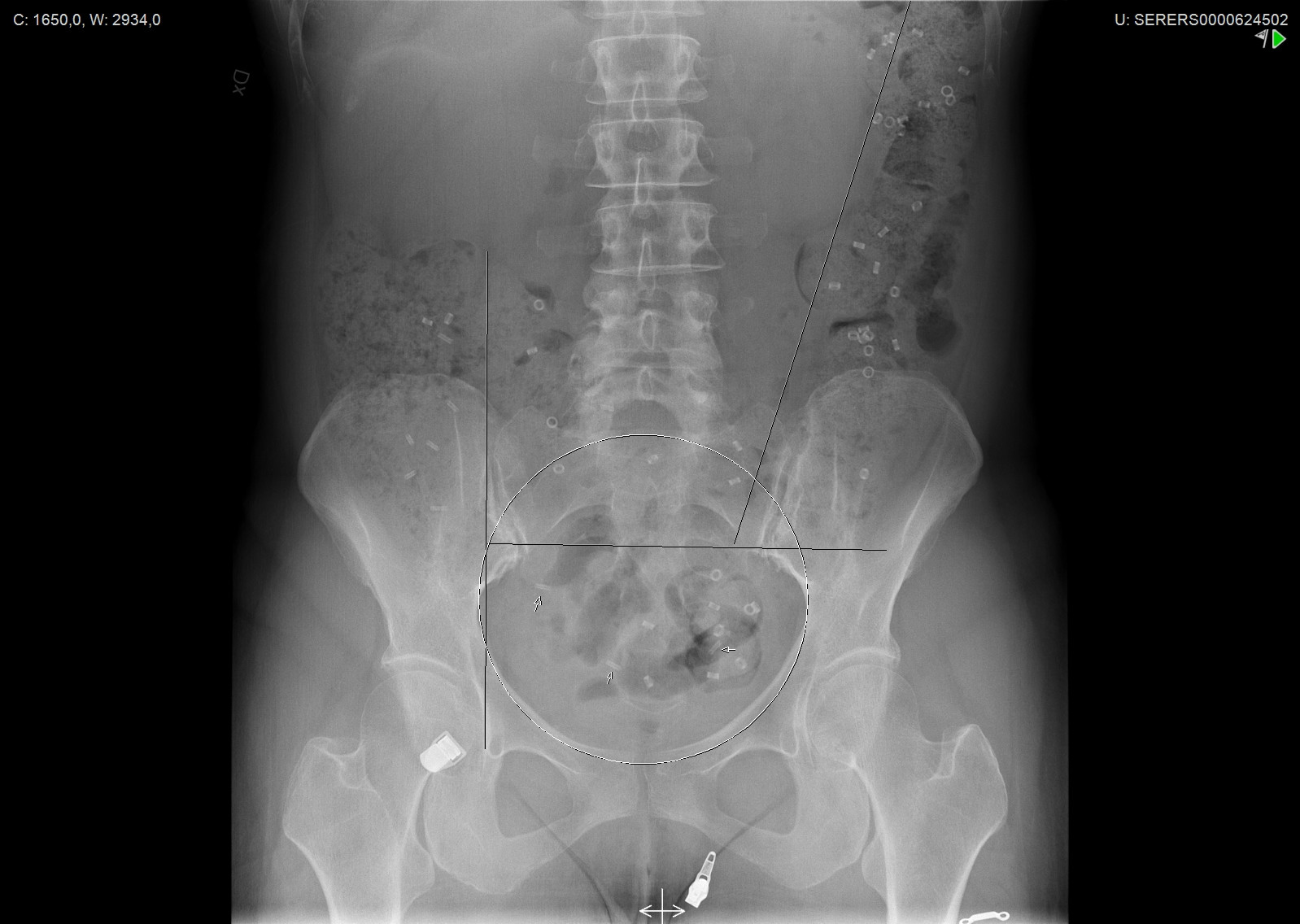Reading the results
Arrange a plain abdominal X-ray on day seven to determine the location and extent of the radiopaque markers. The distribution of markers in the various segments can provide information about the type of delay (see Figure 1). The most commonly used principle in Scandinavia, but also very common outside Scandinavia is to divide the colon into four segments, i.e. caecum-ascending colon, transverse colon, descending colon and sigmoid colon-rectum.
Calculation
Colonic transit time is calculated as the mean oro-anal transit time (OATT) for the daily marker doses swallowed. With a daily dose of ten (10) markers, the transit time in days is M divided by 10, i.e. the number of markers counted from the X-ray film (M) divided by the daily dose. With ten (10) markers per day, each marker is equivalent to 0.1 days or 2.4 hours (i.e. 2.4 hrs. per marker). The formula Number of markers X 2.4 can be used on total and segmental transit time for clinics that prefer a result in hours. A different shape of the markers is used on day six to assist in localization of caecum in patients with slow transit. The division of the day 6-dose into a morning and an evening dose will enhance precision in measuring rapid transit.
Schematic figure: Female patient with 27 markers in the colon (10 tube, 17 ring formed). Transit-time is 2.7 days, i.e. normal.
Interpretation
Both total transit and segmental transit dysfunction in the colon can be evaluated. A numerical transit time value can be given if the number of retained markers is in the range 3–55 markers. Thus, at least half a daily dose should be excreted and at least half of the evening dose on day six must be retained. If the number of retained markers is only 0–2, the transit time is less than 0.3 days. If 56–60 markers are retained, the transit time is more than 5.5 days (an equilibrium has not been reached).
Figure 1: Measurement of colonic transit time with radiopaque markers. A Transit-Pellet test in a female patient who ingested 10 markers daily for 6 days. The plain abdominal radiograph taken on day 7 demonstrates that 55 markers are retained. Thus, colonic transit time is 5.5 days. The markers are evenly distributed throughout the colon; the results indicate slow-transit constipation. Upper reference value is 4.0 days for women and 2.2 days for men. (Source: Medifactia).
Result in days
Colonic transit time (OATT); reference values
Normal transit time corresponds to the range from percentile 5 to percentile 95 in the control material. Reference values based on 199 subjects: 1) Abrahamsson et al, Scand J Gastroenterol 1988 Suppl 152:72-80; 2) Sadik et al, Scand J Gastroenterol 2003, 38:36-42; 3) Törnblom et al, data on file, Gastrointest Lab, Sahlgrenska University Hospital.
Segmental transit time; upper reference values
Segmental transit times: Abrahamsson et al, Scand J Gastroenterol 1988 Suppl 152:72-80. Percentile 95 calculated per segment in healthy subjects.
Result in hours
Colonic transit time (OATT); reference values
Normal transit time corresponds to the range from percentile 5 to percentile 95 in the control material. Reference values based on 199 subjects: 1) Abrahamsson et al, Scand J Gastroenterol 1988 Suppl 152:72-80; 2) Sadik et al, Scand J Gastroenterol 2003, 38:36-42; 3) Törnblom et al, data on file, Gastrointest Lab, Sahlgrenska University Hospital.
Segmental transit time; upper reference values
Segmental transit times: Abrahamsson et al, Scand J Gastroenterol 1988 Suppl 152:72-80. Percentile 95 calculated per segment in healthy subjects.
Application of the result
- Inform the patient!
- Delayed transit → Intensified obstipation treatment
- Slow transit in sigmoid colon-rectum → Investigate possible Outlet obstruction
- Feeling of severe constipation but normal transit → Irritable Bowel Syndrome (IBS)?
- Chronic diarrhea and rapid transit in distal colon → Bile acid diarrhoea?
For further information, please see Clinical Instruction for Use.












